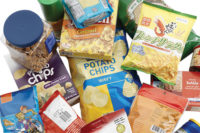Machinery Technology: Marking & Coding
Coding the pharmaceutical packaging industry
An interview with Tim Kearns, national strategic account manager for pharmaceutical & medical devices at Videojet.

Tim Kearns, pharmaceutical and medical devices manager, Videojet

High resolution barcodes are particularly important as cases are transported through the supply chain.

Pharmaceutical manufacturers have wide-ranging marking and printing requirements for cartons, bottles, vials, labels, flexible materials, cases and more.

Continuous inkjet printing is fluid based and works well for non-contact printing on bottles, vials, blister foils, tubes, other flexible packaging.




Today’s pharmaceutical manufacturers are faced with growing regulation and unique packaging demands. Videojet Technologies’ Tim Kearns, national strategic account manager for pharmaceutical & medical devices, weighs in on what’s changing in the industry, how coding fits into an overall packaging strategy and how to effectively address the challenges ahead.
Packaging Strategies: What role does coding play in the pharmaceutical packaging process and is there one best printing or marking technology for pharmaceutical applications?
Tim Kearns: With new industry regulations and a growing focus on serialization, both in the U.S. and globally, the need for dynamic, high resolution printing has become even more important to help ensure a code on every product provides accurate identification. Pharmaceutical manufacturers have wide-ranging marking and printing requirements for cartons, bottles, vials, labels, flexible materials, cases and more. They often require custom solutions to best meet their needs. There is not one ‘best’ technology, but there are certain technologies that are designed to fit well with specific applications:
- Thermal Inkjet (TIJ): Ink-based, non-contact printing on cartons, labels, synthetic fiber materials such as DuPont™ Tyvek®, blister foils
- Laser: Permanent marking on cartons, labels, bottles, blister foils, vials/ampules, tubes
- Thermal Transfer Overprinting (TTO): ribbon-based, high resolution printing on labels, pouches, sachets, other flexible materials
- Continuous Inkjet (CIJ) Printing: fluid based, non-contact printing on bottles, vials, blister foils, tubes, other flexible packaging
Another key area of pharmaceutical coding is the necessary printing on shipping cases and pallets. High resolution barcodes are particularly important as cases are transported through the supply chain. These codes oftentimes contain critical serialization data, which is best achieved with print and apply labelers and high resolution, large character ink jet printers. There can be great advantages to having these printers connected to upstream coding devices and verification systems. My advice to manufacturers is to look at the full range of printing and marking technologies available for each application.
PS: What are some of the key serialization and Drug Supply Chain Security Act (DSCSA) challenges your customers are facing and what are your recommendations for navigating them?
Kearns: In general, meeting the DSCSA requirements is like a puzzle. Manufacturers must have the correct equipment, controllers and interfaces in place that tie into their serialization provider’s solution. Because every customer’s needs vary, serialization solutions need to be customized to best fit each distinct packaging line. Manufacturers need to decide on processes, if necessary, for aggregation and re-work. Also, they should consider whether product coding on a line will need to adhere to regulations in other countries, or be printed in different languages.
Determining responsibilities for coding and serialization is an important step in any implementation. So it is critical to get the key people together early in the process to determine which aspects will be handled internally and which will be handled by vendors or OEM partners. In addition to setup, maintenance and training assignments, identifying service and support resources are important parts of this discussion.
PS: How does coding fit into a pharmaceutical manufacturer’s global packaging strategy?
Kearns: You can find nuances in traceability regulations all over the world. Differences in data transfer, various language requirements, and even barcode variations can cause difficulty for manufacturers’ global operations. For example, the linear barcode required for the China market does not easily fit on all cartons, and finding a location for the code, or reducing the size of the code, can be challenging.
We recently tackled this sort of challenge when one of our global customers shrank a linear GS1-128 barcode to fit more easily on a carton in their Chinese production facility. This shrinking caused a decline in the resolution, and the grading became unacceptable. So we used our local support team in China and worked with the customer’s engineering teams in the U.S. and the UK to address the root cause. As a result, our internal engineering group in Germany worked to update the firmware of our printers to be able to produce higher resolution yet smaller, linear barcodes as required. This successful implementation shows that it can be a huge advantage for manufacturers to work with a partner who has a global support network to address any coding challenges that might arise in production and packaging facilities worldwide.
PS: Can pharmaceutical manufacturers utilize their existing packaging line equipment to address new industry requirements?
Kearns: Regulations such as the DSCSA make it imperative for the pharmaceutical industry to continue to stay on top of new coding technology. With traceability requirements encompassing several levels of operations and packaging, many pharmaceutical manufacturers may need to update both equipment and processes.
Some manufacturers may have the option of using existing equipment if their current technology has the communication and data capabilities to connect to a serialization solution. Manufacturers should work closely with their marking and printing partner so as to address their unique serialization requirements and integrate new and/or update existing solutions.
PS: What are the biggest benefits for pharmaceutical manufacturers in choosing their ideal coding solution?
Kearns: New printing and marking equipment can offer increased controller flexibility and allow for changeovers to happen quickly and seamlessly. When coding products are bound for different international locations, manufacturers can simplify their code changing processes to reap operational benefits such as less downtime, waste and rework as well as enhanced efficiency and traceability.
Tim Kearns, pharmaceutical and medical devices manager, Videojet, focuses on the pharmaceutical and healthcare industries, supporting North American pharmaceutical and medical device customers with their print and laser marking systems and case coding solutions for product packaging identification. Most recently he’s been helping customers tackle serialization and traceability challenges.
Looking for a reprint of this article?
From high-res PDFs to custom plaques, order your copy today!










